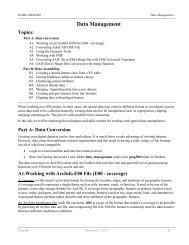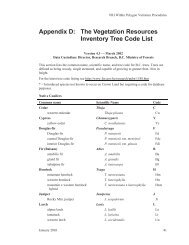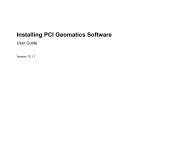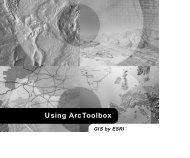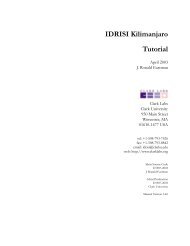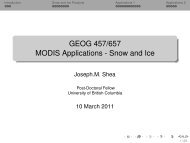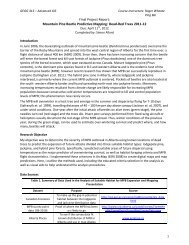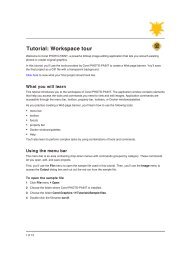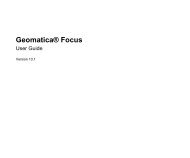Understanding Map Projections
Understanding Map Projections
Understanding Map Projections
Create successful ePaper yourself
Turn your PDF publications into a flip-book with our unique Google optimized e-Paper software.
ROBINSON<br />
Distance<br />
Generally, scale is made true along latitudes 38° N<br />
and S. Scale is constant along any given latitude and<br />
for the latitude of the opposite sign.<br />
LIMITATIONS<br />
Neither conformal nor equal area. Useful only for<br />
world maps.<br />
USES AND APPLICATIONS<br />
Developed for use in general and thematic world<br />
maps.<br />
The central meridian is 118° W.<br />
DESCRIPTION<br />
Also called Orthophanic.<br />
Used by Rand McNally since the 1960s and by the<br />
National Geographic Society since 1988 for general<br />
and thematic world maps.<br />
A compromise projection used for world maps.<br />
PROJECTION METHOD<br />
Pseudocylindrical. Meridians are equally spaced and<br />
resemble elliptical arcs, concave toward the central<br />
meridian. The central meridian is a straight line<br />
0.51 times the length of the equator. Parallels are<br />
equally spaced straight lines between 38° N and S;<br />
spacing decreases beyond these limits. The poles are<br />
0.53 times the length of the equator. The projection<br />
is based on tabular coordinates instead of<br />
mathematical formulas.<br />
LINEAR GRATICULES<br />
All parallels and the central meridian.<br />
PROPERTIES<br />
Shape<br />
Shape distortion is very low within 45 degrees of the<br />
origin and along the equator.<br />
Area<br />
Distortion is very low within 45 degrees of the origin<br />
and along the equator.<br />
Direction<br />
Generally distorted.<br />
Supported map projections• 81




